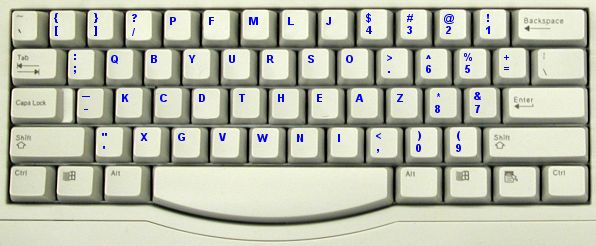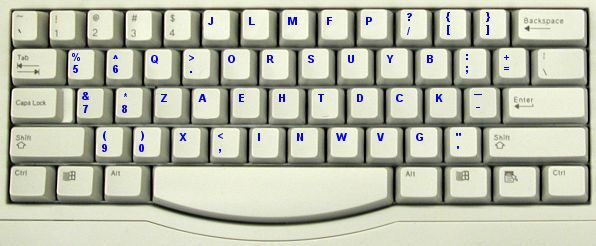[ The PC Guide | Systems and Components Reference Guide | Keyboards | Keyboard Layouts | Alphanumeric Key Layouts ]
Single-Handed Dvorak Alphanumeric Layouts
During World War II, Colonel Robert Allen had the misfortune to lose his right arm. He was a writer, and quickly realized that not only did he have to contend with trying to type with only one hand, he had to deal with the bizarre QWERTY keyboard layout, which scatters common letters all over the place, exacerbating his disadvantage. (Try typing even a simple word like "name" on a QWERTY keyboard with one hand and you'll immediately understand his dilemma!)
In 1945, Colonel Allen contacted August Dvorak and asked for his assistance. Building upon his prior research, Dvorak created two different single-handed keyboard layouts, one for the right hand and one for the left. In both layouts, the keys are organized in a "bulls-eye" pattern of sorts; the most commonly used keys are located where the hand would normally rest; less frequently used keys are further from the center of the layout, and the most infrequently used keys are the farthest away. The right and left designs are close to being mirror images of each other; having two complementary designs reflects the mirror-image relationship of our two hands. It also allows the single hand to be positioned either to the right or left of center for greater comfort. So the right-handed layout has the most common keys to the right of the geographic center of the keyboard, and the left-handed layout has them adjusted to the left.
|
Illustration of the left-handed Dvorak keyboard layout
(above) and the |
Regardless of the controversy surrounding whether the regular two-handed Dvorak keyboard is really better than QWERTY or not, it seems rather obvious that these single-handed designs would be far more suitable for a single-handed typist than QWERTY is. I can't say I've ever had the experience myself of typing single-handed, but I trust common sense on this one. :^) The claim has been made that Colonel Allen, using the left-handed Dvorak keyboard, was typing 50 words per minute a few months after he started using it. Pretty impressive if true, though I don't know absolutely for certain if this actually was the case.
As with the regular Dvorak layout, support for the single-handed Dvorak layouts is included within Windows, using the multiple-language and layout features. For other operating systems patches and drivers are available. See here for more details on keyboard software issues.
![]() Next: International Alphanumeric Layouts
Next: International Alphanumeric Layouts
| The PC Guide
(http://www.PCGuide.com) Site Version: 2.2.0 - Version Date: April 17, 2001 © Copyright 1997-2004 Charles M. Kozierok. All Rights Reserved. |
Not responsible for any loss resulting from the use of this site. Please read the Site Guide before using this material. |

